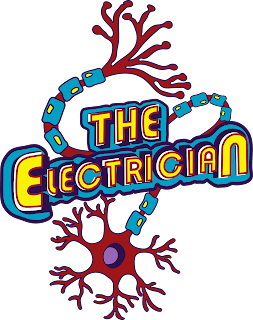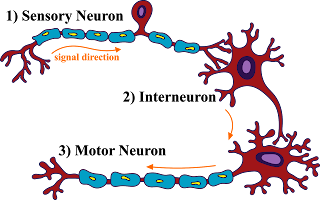The Electrician & The Neuron
By Sabrina Groves, Author &
Illustrator
Need a meal, call a chef. Have a leak, get a plumber.
Intuitive sayings, such as these, drive vocational
understandings and career boundaries. But, are these barriers as defined as
they appear?
In today’s post, I’ll be examining a job swap in an
effort to challenge vocational norms and simultaneously highlight some pretty
cool aspects of the brain. To be fair, I’ve chosen two seemingly different
careers with some notable parallels, so my comparison is not entirely random,
but it serves the point.
Could an electrician double as a neurologist?
Full disclaimer: For the safety of all involved, this
post is hypothetical—no real brains or electricians were harmed in this
exercise.
To answer this, we’ll need a strong definition for
each occupation. I’ve taken the liberty of consulting the U.S. Bureau of Labor
Statistics’ Occupational Outlook Handbook for this. According to BLS, the
functions of each include:
Electrician— install,
maintain, and repair electrical power, communications, lighting, and control
systems
Neurologist— examine,
work with, perform, develop, and research neurons and associated systems
As their root words suggest, the subject matter
doesn’t align. Functionally, they are more similar. Each occupation requires observation,
diagnosis, investigation, and a solution to be implemented in a transmission
system. Wires transfer power and neurons relay information.
What would an electrician do if we replaced a circuit
with a neuron?
The intuitive answer would be to call a neurologist.
If instead, the electrician attempted to work on the neuron, we would expect
several observations:
· Neurons consist of multiple parts
· Two large structures are connected by a thin strand
· Branches on either end resemble the roots of a tree
Researching the subject would provide greater yields,
including a definition and functional properties:
A neuron, also known as a nerve cell, is a specialized
being that transmits and receives nerve impulses, or signals, from one area of
the body to another. Neurons create a pathway through which our body can send
and respond to information, allowing us to sense, move, remember, and so much
more.
The key to connecting neurons is their anatomy.
All neurons consist of ten main parts: the cell body, nucleus, nucleolus, dendrite, axon hillock, axon, myelin sheath, Schwan cell, node of Ranvier, and axon terminal. Luckily for the hypothetical electrician, these anatomical parts function similarly to the components in an electrical circuit (in more ways than one).
Neuron
Anatomy and Function. Photo Credit: Sabrina Groves
The cell body, also called the soma, is the neuron’s base. It maintains the nerve’s structure, provides energy for signaling, and contains the cell’s materials. It is enclosed by a cell membrane that protects and allows for interaction with surrounding structures. This sounds a lot like an electrical plug, which maintains shape, provides electric when connected, houses the prongs and connective pieces for power, and is protected by thick sheathing.
Labelled
Charging Cable. Photo Credit: Sabrina Groves
Inside of the cell body, a nucleus and nucleolus control
and regulate the actions of the cell, much like a fuse regulates whether an
electrical current can flow. Gene expression and DNA replication (jobs of the
nucleus) determine the signals that can be handled, while functionality is
dependent on proteins (the nucleolus’ job).
Branching dendrites act as the prongs of the plug,
receiving and processing signals from other neurons. Just as a strong connection
relays power in each scenario, weak signals and bad connections halt
transmission in neurons and electrical devices.
At the cable grip, three independent wires converge
prior to entering the cable. Similarly, the axon hillock combines membrane potentials
(signal strength differences) to be sent to the axon, a long wire-like
structure that joins the cell body at the axon hillock. Along the axon, myelin
sheaths (produced by Schwan cells) act as wire insulation, allowing the axon to
conduct electrical signals without losing energy to the environment. Small gaps
between the myelin, termed nodes of Ranvier, reduce resistance and facilitate
rapid conduction. In some cases, the axon is bare, allowing for speedy
signaling with minimal resistance.
The axon terminal, a pseudo charging port, marks the
end of the axon. Circular tips, like metal connectors, allow for synaptic
connections with other nerve cells and effectors (muscle and gland cells).
Given the similarities between a single neuron and charging
cable, an electrician with such analogical knowledge would probably do just
fine observing a single neuron and identifying potential problem sites.
Neural
Circuit. Diagram Credit: Sabrina Groves
Could an electrician handle multiple neurons?
Maybe— although this would definitely be a challenge.
Like an electrical circuit, multiple neurons can be
connected to form a neural circuit, a path of nerve cells used to transport
signals from one area of the body to the next. In a neural circuit, individual
neurons are arranged in a line with minute spaces between cells (called
synapses), across which impulses (chemical signals) can pass. The movement across
synapses and membranes is similar to an RC circuit.
Neural circuits require different parts, functionalities,
and uses, as do electrical circuits. There are three main types of neurons:
sensory, motor, and interneurons.
Sensory neurons are cells that activate when
stimulated by the environment. When you realize a stove is hot, a smell
is sweet, or a taste is bitter, your sensory neurons are firing
and sending signals to the rest of the nervous system to describe the sensory
inputs (think: adjectives) that they have received. Reactionary behavior
is less common in electronics, and may pose some difficulties for an
electrician. Experience with motion activated lights, pressure plates, and alarm
systems provide some parallels to this neural technology.
Motor neurons transmit impulses from the brain to the spinal
cord and to muscles, glands, and organs throughout the body, allowing us to
control our movements. Voluntary motions (like reaching out your arm or kicking
a ball) and involuntary motions (including reflexes and breathing) are both
facilitated by motor neurons. Computers are the best analogy for autonomous
action in electronics, but they stray far from the brain’s control system.
Interneurons, also called relay neurons, connect motor
neurons to sensory neurons, allowing signals to be transferred throughout the
body. Interneurons are the extension cords of the neural system, allowing
circuits to stretch across the body.
Despite the parallels between neural and electrical
circuits, an electrician would probably have the most difficulty here. Neural connection
failures require succinct knowledge of symptoms and the corresponding system damage
that can contribute to such maladies. The multitude of parts, not to mention,
the inefficacy of a voltage tester, could throw anyone off. Add in the
magnanimous processing chain, constant sensory input, chemical signaling,
missing insulators, and gaps, and almost anyone could be puzzled.
Maybe an electrician shouldn’t be your impromptu
neurologist… but here’s to the interdisciplinary ones that can try.
Could your electrician handle a neuron? Do
you know of other overlapping careers? What’s your favorite thing about nerve
cells? Let me know what you think in the
comments below.
Share if you know an electrician looking
for a career change.
© 2020 Sabrina L. Groves. Creative Commons
Attribution-Noncommercial 4.0 International License.








Comments
Post a Comment